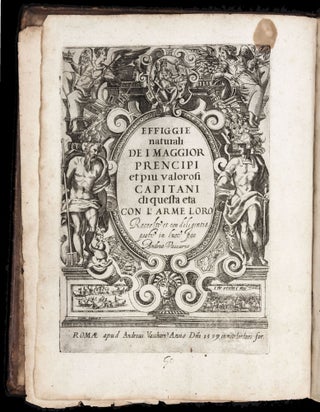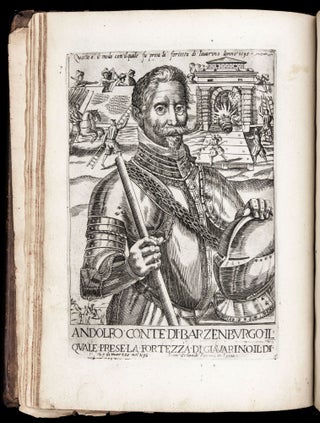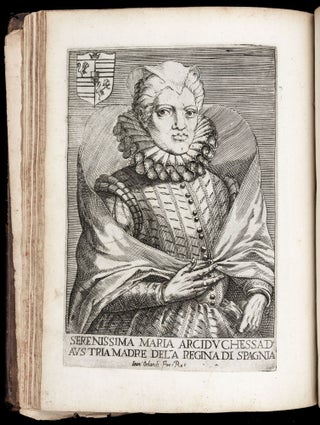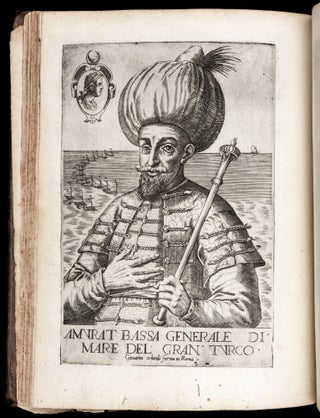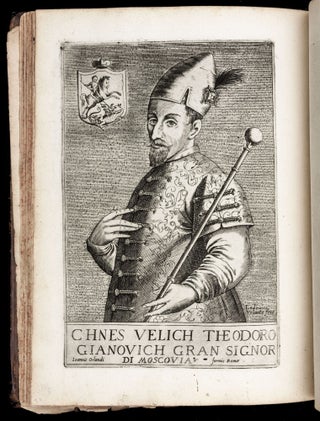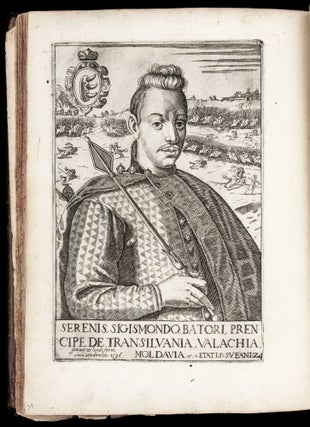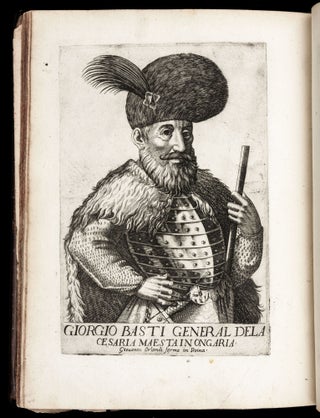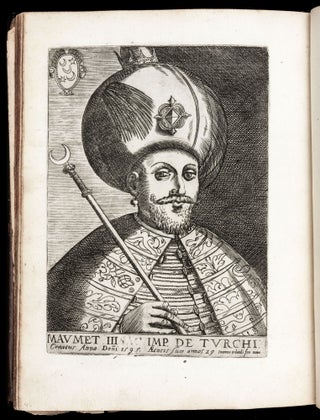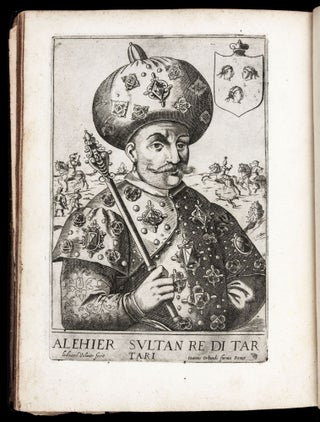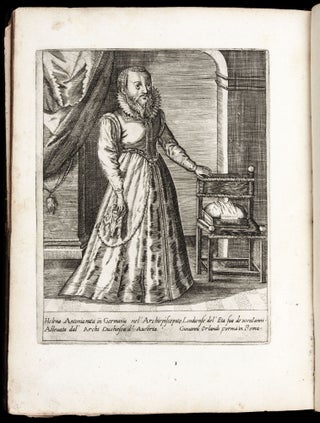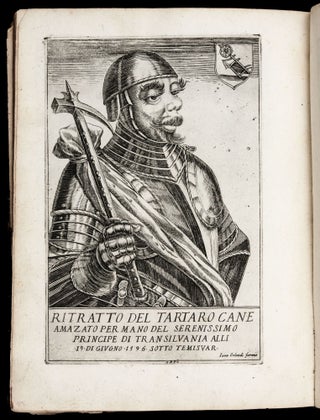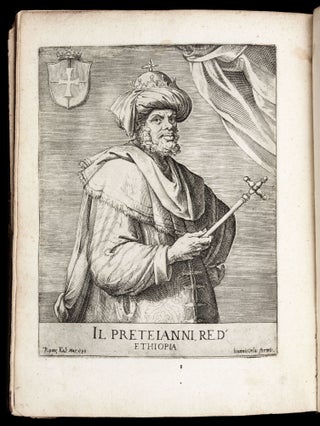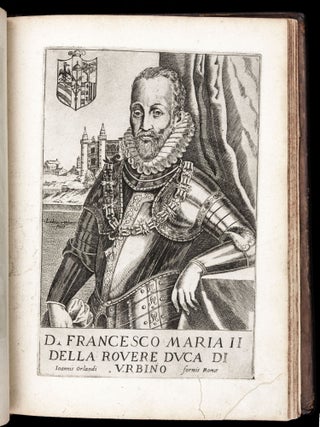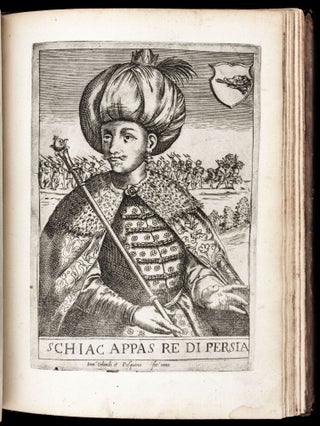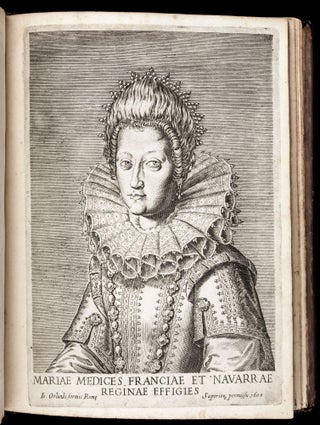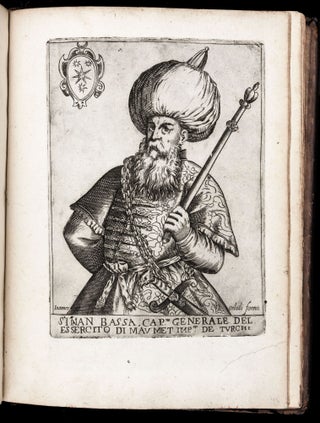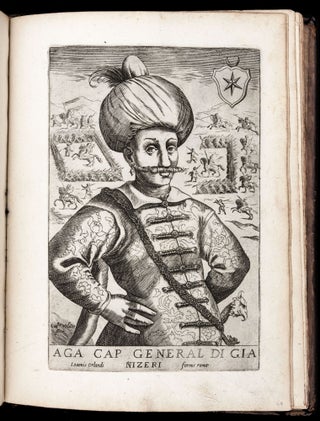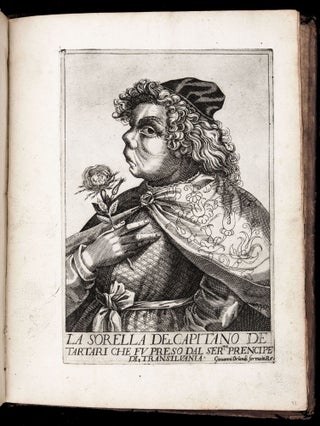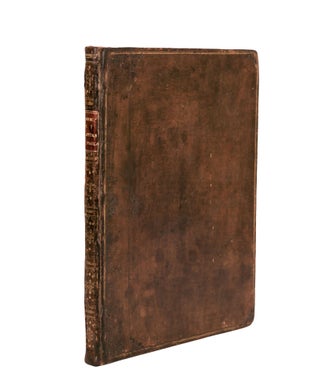Effiggie naturali de i maggior prencipi et piu valorosi capitani di questa eta con l’arme loro.
4to [26.0 x 19.4 cm], (1) f. engraved title, (58) ff. engraved portraits. Bound in 18th-century calf, rebacked, spine restored. Small spot, mostly marginal, just entering image of first five leaves. Bookplate of John Rushout, 2nd Baron Northwick (1770-1859). Very rare suite of 58 late 16th- and early 17th-century engraved portraits of contemporary Western European, Eastern European and Ottoman sovereigns, princes, military figures, and other (sometimes quite bizarre) personages, both male and female, produced in Rome by the publishers Giovanni Orlandi (fl. 1590s, d. 1640) and Andrea Vaccari (fl. from 1595, d. 1627). The engravings are an important witness to the expansion of the genre of portraiture to appeal to and capitalize on a burgeoning public interest in famous individuals in the news at the time, effectively putting faces to names of figures who were being widely discussed in popular journalistic reports. Depicted here are not only the Pope, Doge of Venice, Kings of France and Spain, etc., but also Sultan Mehmed III, Shah Abbas of Persia, Feodor I of Russia, “Prester John, King of Ethiopia” (i.e., Yaqob I), and other living figures of interest to a European audience. The core images of the suite – as well as the title of the suite itself – were borrowed by Orlandi from a 1596 work by the Venetian printer-publisher Giacomo Franco (1550-1620), whose Effiggie naturali consisted of 35 portraits of sovereigns and military figures active during the initial phases of what would come to be known as the Long Turkish War or Thirteen Years’ War (1593-1606), the conflict between the Habsburgs and the Ottoman Empire over the principalities of Wallachia, Transylvania and Moldavia. Printed news pamphlets addressing these wars against the Turks are today considered to be among the first examples of ‘journalism’ in the fullest sense of the word, and Franco apparently hoped that a handbook of “true” portraits of the war’s actors would be well received as a visual supplement to textual reports. In Rome, Orlandi copied some of Franco’s portraits for his own Effiggie naturali (1597), but he also introduced two important innovations: First he added and removed rulers as they died, were deposed, came to power, etc., and second, he supplemented the work with other figures in the headlines of the day. For example, the volume includes portraits of seven famous women, four of royal lineage and three with bizarre physical characteristics: Helena Antonia (1550-95), the bearded female court dwarf of Maria of Austria, Tognina Gonsalvus (b. circa 1588), the hairy girl from the Canary Islands who grew up in court of the Isabella Pallavicina, Marchesa of Soragna; and the sister of a Turkish capitain with grotesque facial features. Orlandi, whose shop was located near the Pasquino in Rome (see Bury, p. 230), published the Effiggie naturali with an engraved title page dated 1597 and later altered it to read 1599. In the present suite, however, Orlandi’s name appears on several portraits which were clearly made after 1599, e.g. the pendant portraits of Henri IV and Marie de Medici (dated 1600) and the plate of Cardinal Scipione Borghese (who was appointed 18 July 1605). The Orlandi copperplates were apparently acquired in the first years of the 1600s by Andrea Vaccari, who (confusingly) continued to reuse Orlandi’s engraved title dated 1599, even while altering the imprint to indicate his shop in the Parione neighborhood of Rome (“in mo(n)te Iordani”; the 1602 portrait of the infant Henri XIII has Vaccari’s imprint as “in Bianchi alla Zecha Vechia”; see Bury, p. 235). The relationship between Orlandi and Vaccari requires further study, but it is clear that the present suite, which has the 1599 Vaccari imprint on the title page, was compiled after 1609-10, for it includes a plate of Archduchess Maria Maddalena of Austria (1589-1631), who took that title at the accession of her husband, Cosimo II, on 17 February 1609. Examples of both the Orlandi and the Vaccari imprints are today very rare, and surviving copies do not contain the same number of plates. In fact, the suite was apparently always conceived of as an open-ended, expandable group of prints of the sort pioneered in Rome by Antonio Lafreri in his Speculum Romanae Magnificentiae and Geografia of the 1570s (see Bury, pp. 47-51, 121-35). A title page was produced to package the prints together for sale, but the fact that they were not individually numbered in the plate, that some plates carry an address in the manner of a separately issued print, and that individual, loose examples of these engravings are to be found in print rooms today all suggests that Vaccari offered the prints both individually and in (ever changing) groups. A stock-list of the Vaccari holdings in 1614 emphasizes the ongoing, contemporary nature of this portrait suite, noting that it treated only “living” figures (“Vn libro di sessanta pezzi dell’effigie delli Capitani Illustri et Prencipi viuenti, intagliati per mano di diuersi valent’huomini,” see Ehrle, p. 64, lines 498-99). OCLC and KVK locates only one U.S. example of the 1599 Orlandi imprint, at the Folger Library (51 engravings). No examples of the “1599” Vaccari imprint are recorded in U.S. institutions; copies of the Vaccari imprint found elsewhere contain between 33 plates (Cicognara) and 55 plates (London National Portrait Gallery). *F. Ehrle, Roma prima di Sisto V: La pianta Du Pérac-Lafréry del 1577; M. Bury, The Print in Italy 1550-1620; C. Pasero, “Giacomo Franco, editore, incisore e calcografo nei secoli XVI e XVII,” La Bibliofilía, vol. 37, no. 8-10 (1935), pp. 332-356, no. xix (Franco); B. Wilson, “Reflecting on the Turk in late sixteenth-century Venetian portrait books,” Word and Image, vol. 19, no. 1 & 2 (2003), pp. 38-58; C. Espejo, “The Prince of Transylvania: Spanish News of the War against the Turks, 1595-1600,” in J. Raymond and N. Moxham, eds., News Networks in Early Modern Europe, pp. 512-41.
Sold


